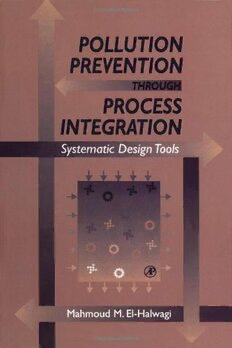Download Pollution prevention through process integration: systematic design tools PDF Free - Full Version
Download Pollution prevention through process integration: systematic design tools by Mahmoud M. El-Halwagi in PDF format completely FREE. No registration required, no payment needed. Get instant access to this valuable resource on PDFdrive.to!
About Pollution prevention through process integration: systematic design tools
The environmental impact of industrial waste is one of the most serious challenges facing the chemical process industries. From a focus on end-of-pipe treatment in the 1970s, chemical manufacturers have increasinglyimplemented pollution prevention policies in which pollutants are mitigated at the source or separated and recovered and then reused or sold. This book is the first to present systematic techniques for cost-effective pollution prevention, altering what has been an art that depends on experience and subjective opinion into a science rooted in fundamental engineering principles and process integration. Step-by-step procedures are presented that are widely applicable to the chemical, petrochemical, petroleum, pharmaceutical, food, and metals industries. Various levels of sophistication ranging from graphical methods to algebraic procedures and mathematical optimization, numerous applications and case studies, and integrated software for optimizing waste recovery systems make Pollution Prevention through Process Integration: Systematic Design Tools a must read for a wide spectrum of practicing engineers, environmental scientists, plant managers, advanced undergraduate and graduate students, and researchers in the areas of pollution prevention andprocess integration. 1Allows the reader to establish pollution-prevention targets for a process and then develop implementable, cost-effective solutions 1Contains step-by-step procedures that can be applied to environmental problems in a wide variety of process industries 1Integrates pollution prevention with other process objectives 1Author is internationally recognized for pioneering work in developing mass integration science and technology 1CD-ROM contains software for design of waste recovery networks (MEN) and optimization (LINGO()
Detailed Information
| Author: | Mahmoud M. El-Halwagi |
|---|---|
| Publication Year: | 1997 |
| ISBN: | 9780122368455 |
| Pages: | 335 |
| Language: | English |
| File Size: | 19.581 |
| Format: | |
| Price: | FREE |
Safe & Secure Download - No registration required
Why Choose PDFdrive for Your Free Pollution prevention through process integration: systematic design tools Download?
- 100% Free: No hidden fees or subscriptions required for one book every day.
- No Registration: Immediate access is available without creating accounts for one book every day.
- Safe and Secure: Clean downloads without malware or viruses
- Multiple Formats: PDF, MOBI, Mpub,... optimized for all devices
- Educational Resource: Supporting knowledge sharing and learning
Frequently Asked Questions
Is it really free to download Pollution prevention through process integration: systematic design tools PDF?
Yes, on https://PDFdrive.to you can download Pollution prevention through process integration: systematic design tools by Mahmoud M. El-Halwagi completely free. We don't require any payment, subscription, or registration to access this PDF file. For 3 books every day.
How can I read Pollution prevention through process integration: systematic design tools on my mobile device?
After downloading Pollution prevention through process integration: systematic design tools PDF, you can open it with any PDF reader app on your phone or tablet. We recommend using Adobe Acrobat Reader, Apple Books, or Google Play Books for the best reading experience.
Is this the full version of Pollution prevention through process integration: systematic design tools?
Yes, this is the complete PDF version of Pollution prevention through process integration: systematic design tools by Mahmoud M. El-Halwagi. You will be able to read the entire content as in the printed version without missing any pages.
Is it legal to download Pollution prevention through process integration: systematic design tools PDF for free?
https://PDFdrive.to provides links to free educational resources available online. We do not store any files on our servers. Please be aware of copyright laws in your country before downloading.
The materials shared are intended for research, educational, and personal use in accordance with fair use principles.

